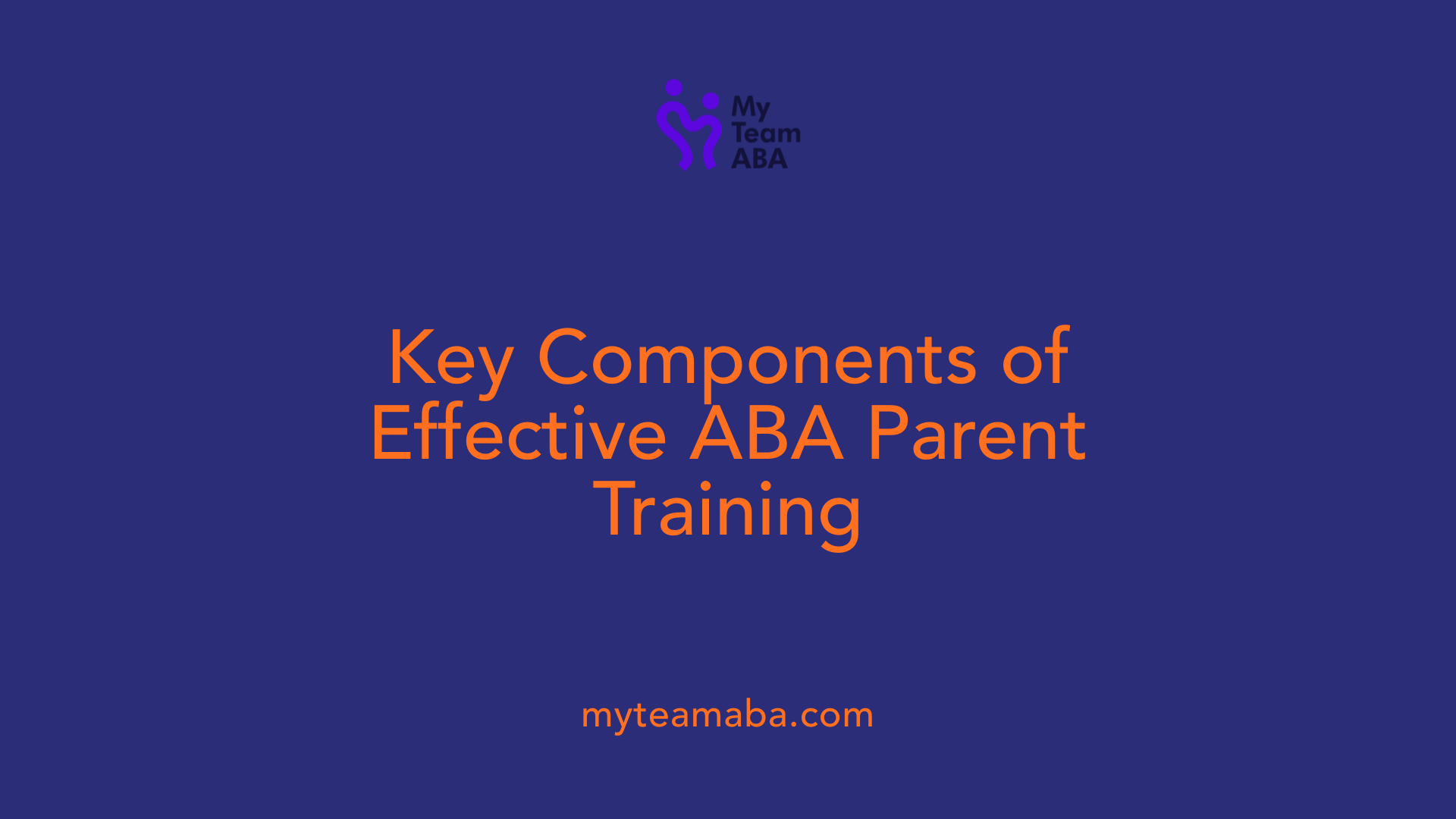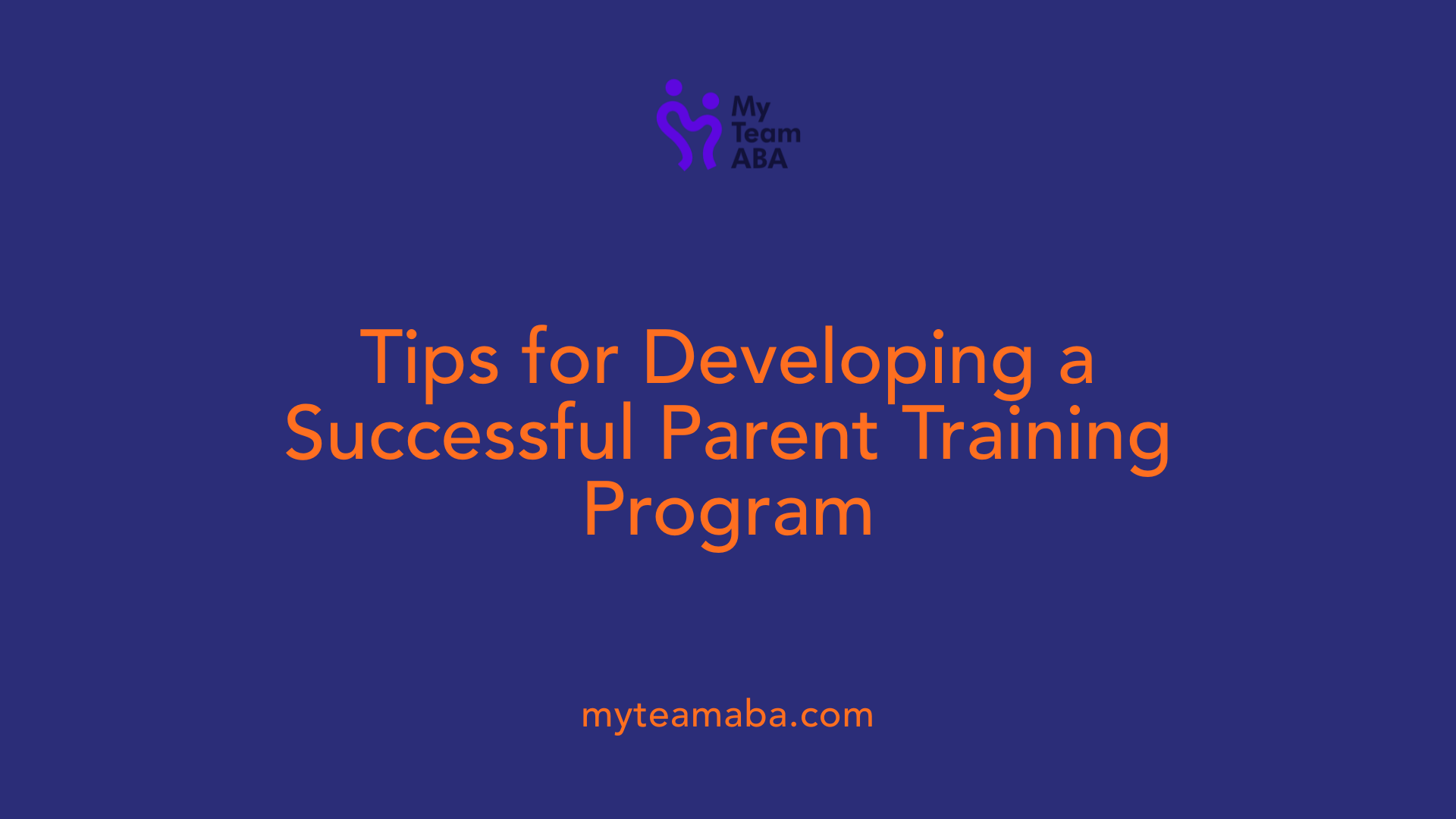Building a Strong ABA Strategy with Consistent Parent Training
November 2, 2025
Empowering Families for Autism Success: The Key to Effective ABA Strategies

The Crucial Role of Parent Involvement in ABA Therapy
Building a robust ABA strategy is not just about the interventions used in clinical settings; it's fundamentally anchored in the active involvement and training of parents. Consistent parent training enhances the generalization of skills, reliability of behavior management, and overall therapy outcomes for children with autism. This article explores the essential components, techniques, and best practices that create a sustainable and collaborative approach between parents and professionals, paving the way for meaningful and lasting developmental progress.
Objectives and Benefits of ABA Parent Training Programs
What are the objectives and benefits of ABA parent training programs?
ABA parent training programs are designed to help parents understand and implement behavioral strategies rooted in Applied Behavior Analysis (ABA). The main goal is to empower caregivers with the skills needed to support their child's development consistently and effectively. This includes teaching parents how to reinforce positive behaviors, manage challenging ones, and promote skill generalization across different environments such as home, school, and community.
One of the significant benefits of these programs is improved behavior management. Parents learn how to apply strategies like positive reinforcement, prompting, and shaping to help children acquire new skills and reduce problematic behaviors.
Another advantage is the enhancement of communication and social skills. With proper training, parents can facilitate natural interactions, support language development, and help children navigate social situations more effectively.
Beyond skill development, ABA parent training fosters increased parental confidence and reduces stress. Parents gain a deeper understanding of their child's behaviors, feel more capable of managing daily challenges, and experience less anxiety related to their child's progress.
Additionally, active parental involvement promotes better generalization of skills from therapy sessions to everyday life, ensuring that children retain and use new abilities across various settings. Collaboration between parents and behavior analysts strengthens the consistency and effectiveness of intervention plans.
Ultimately, these training programs are essential for maximizing a child's developmental gains, fostering independence, and enhancing overall well-being. They also contribute to family cohesion by creating a collaborative atmosphere that supports the child's growth and sets a foundation for long-term success.
Core Components and Principles of Effective ABA Parent Training

What are the key components and principles of effective ABA parent training?
Effective ABA parent training is a structured process that equips caregivers with practical strategies to support their child's development. It mainly involves teaching parents hands-on techniques such as reinforcement, prompting, shaping, and the use of visual supports tailored to their specific family needs.
A fundamental aspect is fostering clear communication and collaboration between therapists and parents. This collaboration ensures that interventions are consistent across settings, which is vital for skill generalization. Setting realistic, measurable goals allows families to track progress and stay motivated.
Techniques like role-playing and modeling are used during training sessions, with therapists providing ongoing feedback to help parents confidently implement techniques. Behavioral Skills Training (BST), which combines instructions, demonstrations, rehearsal, and feedback, is often employed to enhance skill mastery.
Addressing common barriers such as parental stress and time constraints is also essential. Strategies include integrating ABA techniques into daily routines and providing emotional support. Together, these elements create an empowering environment for families.
Ultimately, successful parent training promotes consistency, supports independence, and improves long-term outcomes for children. It helps families understand and apply ABA principles effectively, ensuring that learned behaviors are maintained and generalized across different environments.
| Component | Description | Additional Notes |
|---|---|---|
| Reinforcement & Prompting | Using rewards and cues to encourage desired behaviors | Critical for shaping new skills |
| Visual Supports & Routines | Organizing environments with visual aids and predictable schedules | Enhances understanding and reduces anxiety |
| Goal Setting | Establishing clear, achievable objectives | Facilitates progress tracking |
| Modeling & Rehearsal | Demonstrating techniques through role-play, with feedback | Builds parental confidence |
| Addressing Barriers | Managing stress, time, and cultural considerations | Improves engagement and adherence |
This integrated approach ensures that parents are active, confident participants in their child's developmental journey, leading to more consistent and effective outcomes.
Creating a Supportive Environment for Parents and Children

How can a supportive environment be created for both parents and children in ABA?
Establishing a nurturing and structured environment is essential for effective ABA therapy. It begins with fostering open and respectful communication among parents, therapists, and educators. This collaboration ensures everyone shares a common understanding of goals and strategies, leading to more consistent support for the child's development.
Integrating ABA principles into both home and school settings can significantly enhance progress. This involves developing individualized behavior plans, conducting staff training, and creating collaborative teams that focus on consistent interventions. Such efforts promote the generalization of skills and reduce behavioral challenges across environments.
Creating structured spaces with visual supports, clear routines, and reinforcement systems helps children comprehend expectations. Visual schedules and designated zones at home make daily routines predictable, which decreases anxiety and promotes engagement.
Addressing sensory sensitivities through environmental modifications—like quiet zones or sensory-friendly tools—can help children manage their sensory preferences and reduce meltdowns.
Fostering peer inclusion is another vital aspect. Encouraging social interactions and awareness through discussions and peer-mediated activities nurtures social acceptance, confidence, and friendship development.
Monitoring each child's reactions and progress allows caregivers and therapists to tailor the environment continuously. Flexibility and predictability in routines support both behavioral and emotional well-being for the child and reduce parental stress.
In summary, by implementing structured routines, visual supports, sensory adaptations, and fostering inclusive social environments, families and professionals can build a supportive, predictable, and engaging setting that promotes growth and success for children with autism in ABA programs.
Effective Parent Involvement in ABA Therapy
How can parents be effectively involved in ABA therapy to support their child's progress?
Parents play a crucial role in the success of ABA therapy by actively engaging in various aspects of their child's treatment. One of the most effective ways to do this is through participating in training sessions and workshops led by qualified behavior analysts. These sessions provide parents with hands-on experience and knowledge about ABA strategies such as positive reinforcement, prompting, shaping, and naturalistic teaching.
Equipping parents with detailed resources, like parent guides or manuals, helps clarify ABA principles and provides step-by-step instructions on implementing behavior plans, collecting data, and managing specific behaviors. These resources serve as valuable references for daily routines and can be revisited whenever needed.
Consistency in applying learned skills across different settings—home, community, and school—is vital for promoting skill generalization. When parents reinforce positive behaviors regularly and in various environments, children tend to acquire new skills more effectively and maintain them over time.
Another important aspect of parental involvement is maintaining open lines of communication with ABA therapists. Regular discussions about progress, challenges, and strategy adjustments ensure that interventions stay targeted and responsive to the child's changing needs. Collaboration also fosters a sense of shared responsibility and motivation.
Building confidence and emotional resilience is also essential for parents. Gaining a deeper understanding of ABA techniques helps reduce anxiety and frustration, allowing parents to support their child's development with patience and empathy. Balancing structured intervention with opportunities for unstructured play and emotional expression creates a supportive environment conducive to growth.
In summary, through active participation in training, consistent use of strategies, ongoing communication with professionals, and fostering emotional strength, parents can significantly enhance their child's progress in ABA therapy. This collaborative approach not only accelerates developmental gains but also reinforces the child's sense of security and independence.
Implementing ABA Strategies at Home Through Parent Training
How can ABA strategies be implemented and supported at home through parent training?
Implementing ABA techniques at home is essential for reinforcing learning and promoting meaningful progress in children with autism. Parent training plays a vital role by equipping caregivers with the fundamental principles of ABA, such as positive reinforcement, prompting, shaping, and naturalistic teaching.
Parents learn practical tools like visual schedules, reward systems, and routines that create a structured environment conducive to learning. Hands-on methods, including role-playing and modeling, are commonly used during training sessions to help caregivers practice and apply new skills effectively.
Open and ongoing communication with ABA therapists allows parents to tailor strategies specifically to their child's unique needs. Setting realistic and measurable goals enables families to track progress and celebrate milestones.
Responding calmly and consistently to challenging behaviors, while identifying potential triggers like sensory sensitivities or environmental factors, helps in implementing effective behavior management techniques.
Creating a predictable and sensory-friendly environment with visual supports, organized routines, and clear expectations encourages independence and skill generalization across different settings.
Regular collaboration with ABA professionals, including BCBAs and RBTs, ensures that strategies remain aligned with the child's evolving needs. This partnership fosters confidence in applying techniques at home and supports long-term developmental gains.
In summary, parent training that combines education, practical tools, and ongoing support empowers caregivers to implement ABA strategies successfully, thereby enhancing their child's developmental trajectory and quality of life.
The Impact of Parent-Involved ABA Strategies on Child Progress
How does supporting children's progress through parent-involved ABA strategies work?
Supporting children’s growth with active parent participation in ABA therapy relies on empowering parents through education, coaching, and ongoing support. When parents learn ABA techniques such as positive reinforcement, prompting, and behavior shaping, they can consistently implement these strategies in everyday life.
This consistency is vital for reinforcing skills learned during therapy sessions and ensuring they transfer to natural settings like home, school, and community. As parents apply ABA principles at home, children experience reinforced learning, which enhances skill acquisition and encourages the maintenance of positive behaviors.
Moreover, involving parents increases their confidence and sense of empowerment. When parents see their efforts translating into progress for their children, they become more motivated and engaged.
Regular communication between parents and therapists helps tailor intervention strategies to each child's needs. The collaborative approach promotes faster progress and long-term retention of skills.
Overall, parent involvement not only accelerates developmental gains but also ensures that improvements are sustained over time, making ABA therapy more effective and meaningful.
Best Practices and Tips for Developing a Successful Parent Training Program

How can parents ensure the effectiveness of their engagement in ABA training?
Developing a successful parent training program centers around setting realistic and clear goals from the outset. These goals should be specific, measurable, achievable, relevant, and time-bound (SMART), helping parents and therapists track progress effectively.
Providing culturally sensitive and trauma-informed strategies is vital. Training should respect family backgrounds, values, and individual circumstances, ensuring that techniques are relevant and accessible, which boosts engagement and retention.
Active participation is key. Therapists can foster this by maintaining transparent communication, building trust, and utilizing motivational techniques such as offering incentives, providing flexible scheduling, and encouraging open dialogue. These strategies make parents feel valued and supported.
Monitoring progress regularly is essential. Using data collection tools, such as behavior tracking charts, clinicians and parents can evaluate what's working and what needs adjustment. This ongoing feedback allows strategies to be tailored to the child's evolving needs, enhancing effectiveness.
Offering continuous support and resources sustains long-term success. This might include follow-up sessions, access to online materials, support groups, and community resources. Educating parents about available services equips them with tools to handle challenges independently.
Addressing practical barriers like time constraints and parental stress is equally important. Solutions include offering sessions outside school hours, providing childcare during meetings, and connecting parents with emotional support networks. These efforts reduce dropout rates and foster sustained involvement.
Incorporating a variety of components—such as positive discipline techniques, effective communication strategies, emotional regulation, and problem-solving skills—can produce holistic benefits. Close collaboration between providers and families fosters a supportive environment conducive to success.
Workforce training is crucial. Ensuring that practitioners are skilled in delivering high-quality, adaptable interventions like STEP, Triple P, or the Incredible Years guarantees that parents receive evidence-based practices.
Finally, community engagement and addressing logistical challenges like transportation ensure that support is accessible and continuous. When families feel supported both at home and within the community, they are more likely to maintain consistent participation.
By combining goal setting, cultural sensitivity, active engagement, regular monitoring, ongoing support, and barrier reduction, parent training programs in ABA can generate meaningful, lasting improvements in children's development and family well-being.
Fostering Long-Term Success Through Parent Collaboration
In conclusion, building a strong ABA strategy hinges on the active and consistent involvement of parents through comprehensive training, collaboration, and environmental support. Effective parent training programs empower caregivers to implement ABA principles confidently, facilitate skill generalization, and maintain therapeutic gains across diverse environments. Creating a supportive, organized home environment, fostering open communication, and addressing barriers are vital for sustaining progress. When parents are equipped, informed, and engaged, they become vital partners in the journey towards their child's independence and well-being, ultimately maximizing the effectiveness of ABA therapy and setting the stage for long-term success.
References
- How ABA Therapy Builds Consistency for Lasting Success
- Effective ABA Parent Training - Brady Behavioral Analysis
- Parent Training in ABA: Strategies for Autism Support
- Behavioral Parent Training: Important Tips and Strategies | Regis
- The Role of Family in ABA Therapy: Tips for Parents
- Mastering ABA at Home: Essential Parent Training Tips | Childwise
- Mastering Parent Training in ABA: A Comprehensive Guide
